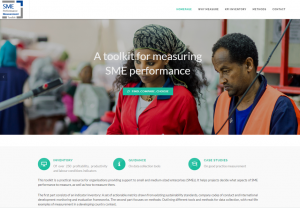A Toolkit to Measure the Performance and Labour Conditions in Small and Medium Enterprises
Guest post from ILO The Lab

Performance measurement is critical not only to see whether enterprise development projects are making a difference, but so that small and medium enterprises (SME) themselves can continuously improve. As the saying goes: “If you can’t measure something, you can’t understand it. If you can’t understand it, you can’t control it. If you can’t control it, you can’t improve it.” In other words, the measurement of performance is the first step towards the management of performance.
Enterprise development projects need to measure changes in SME performance, not only to report results to project funders, but also to help SMEs continuously improve. But measuring the performance of SMEs in the context of a developing economy brings special considerations, including:
- Pressing capacity challenges in record keeping, data collection, and access to modern management techniques – along with the technology that drives it. Most SMEs have some kind of performance measurement system, however, these tend to be very basic.
- Intensely competitive environments where there is little market differentiation – meaning most SMEs have to tussle just to survive, reducing the incentive to collect and use data. Some countries have 5-year survival rates as low as 10%.
- Flatter management structures, less bureaucracy and – in theory at least – can be more agile and adaptive to use performance information to improve.
- SME’s dependence on productivity gains to maximise long-term competitiveness and profitability. In the absence of intellectual property or technology as a source of comparative advantage, labour productivity is often critical to sustaining SME performance.
Moreover, enterprise development projects are facing increasing pressure to demonstrate that their work is leading to qualitative improvements in people’s terms and conditions of employment. As researchers have noted, it is “not only the number, but also the quality of jobs matters to poverty alleviation and economic development”.
For many SMEs in the global south, workers are a critical determinant of business success. Since SMEs often undertake labour-intensive activates, they rely on a supply of labour – with varying skills requirements – to produce their goods and services. Labour and employment issues are frequently included in non-financial performance measurement systems, but they often only focus on the most easily quantifiable elements such as the number of accidents. However, labour conditions refer to the working environment and all circumstances affecting the workplace, including job hours, physical aspects, and the rights and responsibilities of SMEs towards their workers. Many aspects of this work environment are covered by national labour laws, which in turn are shaped by the eight fundamental ILO conventions.
By improving labour conditions, SMEs can improve their business outcomes. Better health and safety practices can boost productivity and employee retention. Companies have shown growth in sales per employee workforce hour following targeted training programmes. As recent research has demonstrated, jobs with decent wages, predictable hours, sufficient training, and opportunities for advancement can be a source of competitive advantage. For many businesses, thinking about employee working conditions has shifted from a way to minimize risk to a competitive advantage.
Conversely, bad conditions can be bad for business: Poor health and safety practices can result in fines and slow task completion. Industrial action and absenteeism can lead to prolonged disruption to operations. An SME owner says, “You have to have an environment where people are happy working, where they cooperate well, interact well. If you have problems in the way people work, it could terribly affect the performance”.
Against this complex framework and challenges, the International labour Organization has launched the ILO SME Measurement Toolkit.
This Toolkit is a practical resource for practitioners and and projects to support SMEs decide what aspects of SME performance (productivity, working conditions, etc.) to measure, as well as how to measure them.
- +250 indicators including a set of actionable metrics drawn from existing sustainability standards, company codes of conduct and international development monitoring and evaluation frameworks
- Methods outlining different tools and data collection techniques
- Real-life examples of SME measurement in a developing country context
We’d love to hear your comments, questions and suggestions about the Toolkit. Drop us an email at thelab@ilo.org!
More ILO The Lab’s resources on results measurement:
You might also like
-
Hands on with GenAI: predictions and observations from The MERL Tech Initiative and Oxford Policy Management’s ICT4D Training Day
-
When Might We Use AI for Evaluation Purposes? A discussion with New Directions for Evaluation (NDE) authors
-
A visual guide to today’s GenAI landscape
-
Register now for the NLP-CoP Ethics and Governance Working Group Meeting on April 18th